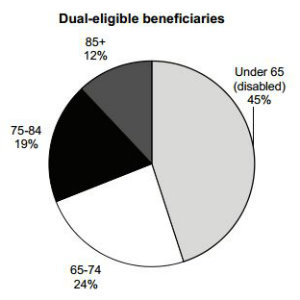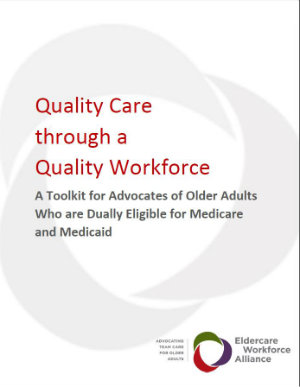 We were introduced to Sally and her daughter Edna last year in a video from our grantee Community Catalyst. I learned recently that Sally has since passed away, but I am so grateful that her and her daughter’s story lives on.
We were introduced to Sally and her daughter Edna last year in a video from our grantee Community Catalyst. I learned recently that Sally has since passed away, but I am so grateful that her and her daughter’s story lives on.
It embodies the promise of the Voices for Better Health initiative, which advocates for quality care for low-income older adults and younger disabled people dually enrolled in both Medicare and Medicaid, as Sally was.
And fortunately, as states rapidly move to integrate Medicare and Medicaid financing and care for the “duals” population, advocates from Voices for Better Health and anyone concerned about people like Sally have a new resource.
Given that almost 60 percent of the duals population are older adults, the Eldercare Workforce Alliance, in partnership with Community Catalyst, has created the Quality Care through a Quality Workforce toolkit, which is helping advocates and health professionals make the case to their state officials and health plan administrators about the need for a well-trained, geriatric-competent workforce that can meet the needs of older adults with complex conditions.
 For those of you not actively involved in the move to integrate care for the duals population, this new toolkit can help get you up to speed and maybe get you excited about getting involved. The toolkit can also be useful in more generally advocating for a geriatric-competent workforce for all older adults.
For those of you not actively involved in the move to integrate care for the duals population, this new toolkit can help get you up to speed and maybe get you excited about getting involved. The toolkit can also be useful in more generally advocating for a geriatric-competent workforce for all older adults.
The Eldercare Workforce Alliance has a number of useful tools and resources, thanks to their 30 member organizations representing consumers, family caregivers, the direct-care workforce, and healthcare professionals. And this toolkit is another example that builds on those members’ on-the-ground experience.
In addition to the thorough and useful explanation of the issues and workforce interventions in the first two modular components of the toolkit, the third section on strategies and tools is particularly helpful for advocates looking for concrete steps to take.
 Click on the toolkit cover for a PDF.
Click on the toolkit cover for a PDF.With a federal demonstration project under way, 13 states are in the process of moving large numbers of people like Sally into new integrated health plans. This move could affect almost 1.8 million people over the next two to three years and is being closely watched by other states that are highly interested in lowering costs and providing better care to the duals population.
Integrated care that addresses all medical, behavioral, and social support needs for vulnerable older adults holds great potential for improved care, such as the kind that Sally eventually received through Commonwealth Care Alliance, an example of an integrated health plan.
On the other hand, with lots of money in play and rapid changes occurring, there is danger for people like Sally.
Community Catalyst is working with state consumer advocacy coalitions to protect people in new integrated plans on a number of fronts: allowing patients to choose plans or providers that can best serve their needs, emphasizing community and home-based services over institutional care, creating payment rates that ensure the needs of those with the most complex conditions are met, and respecting the cultural and linguistic needs of patients and caregivers.
The Eldercare Workforce Alliance toolkit is a valuable new resource that can help all of us clearly articulate to state officials and health plan administrators the reasons why it is critical that those who provide care to older adults in the duals population have the specific skills and expertise to meet their needs and treat them with the dignity and compassion they deserve.
This is the 12th in an occasional series. See other Health AGEnda posts on Tools You Can Use:
Tools You Can Use: Webinar Series Covers Geriatrics-Competent Care for Medicare-Medicaid Population
Tools You Can Use: The Essentials of Cardiovascular Care in Older Adults
Tools You Can Use: Geriatric Transitions Objective Structured Video Examination
Tools You Can Use: A New APProach to Treating Older Patients
Tools You Can Use: Detecting Cognitive Impairment During the Medicare Annual Wellness Visit
Tools You Can Use: Preparing a Personal Advance Care Plan
Tools You Can Use: Guidelines for Assessing Patients Facing Surgery
Tools You Can Use: Principles for Treating Patients with Multiple Chronic Conditions
